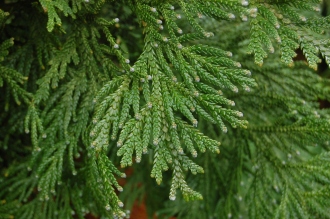Position: Full sun to light shade
Flowering period: Summer
Soil: Moist, well drained
Eventual Height: 15m
Eventual Spread: 8m
Hardiness: 6a, 6b, 7a, 7b, 8a, 8b, 9a, 9b
Family: Cupressaceae
Thujopsis dolabrata is an evergreen small tree with a conical habit. Its glossy, deep green leaves are scale like, have a fleshy texture and up to 3mm long. Its trunk may achieve a diameter of up to 1.5m. Its red/ brown bark is thin and peels off in vertical strips. Its blue/ violet monoecious flowers are small, terminal pollen cones. Its fruit are brown seed cones, ovoid, up to 15mm long and 1cm across.
Thujopsis dolabrata, commonly known as Asunaro, Hiba, False Abrovitae or Hiba Abrovitae, is native to Japan. Thujopsis dolabrata is the only member of this genus. It was introduced into the UK in the 1850’s
The etymological root of the binomial name Thujopsis from the tree name Thuja and the Greek opsis meaning ‘like’, i.e. like a Thuja. Dolabrata is derived from the Latin dolabra meaning ‘pick-axe’, in reference to the shape if this tree’s scale like leaves.
The landscape architect may find Thujopsis dolabrata useful as an ornamental specimen tree. This tree may also be specified as an evergreen hedge.
Ecologically, Thujopsis dolabrata may provide shelter for some bird species.
The Royal Horticultural Society has given Thujopsis dolabrata their prestigious Award of Garden Merit in 1993.
Thujopsis dolabrata prefers moist, fertile, well-drained soils. It tolerates most pH of soil. It will not tolerate dry soils.
Thujopsis dolabrata requires little maintenance.
![]()
Landscape Architecture






Leave a comment